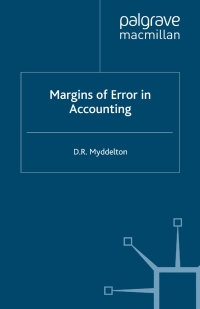Question
After taking business classes, Hannah decided to start her own web-based business that would make use of one of her hobbies. She is selling custom-ordered,
After taking business classes, Hannah decided to start her own web-based business that would make use of one of her hobbies. She is selling custom-ordered, fabric headbands over the internet for $10 each. Shipping and handling costs are paid by the customer. The fabric and elastic used to make the headbands costs $1 per headband. Hannahs mother, aunt, and sister, who are avid seamstresses, have agreed to sew the headbands for a price of $3 each. (They serve as contract manufacturers.) Hannah has also hired an internet marketing firm to maintain the web site and place banner ads on search engines and other websites. This firm charges Hannah $1,000 per month plus 20% of sales revenue. Hannah also spends $500 per month on other operating expenses such as travel, internet access, textile industry membership fees, lease of her office equipment, etc. Hannah believes she can handle the business unless it grows beyond 4,000 units a month. If volume exceeds 4,000 per month, shell need to hire additional help in managing the business, as well as non-family members who might charge more to do the work.
- What is Hannahs gross profit per headboard?
- Which measure of profitability gives managers a more realistic idea of profitability? Why?
- How is a contribution margin income statement formatted? Create one for Hannahs business, assuming she sells 2,300 headbands in June.
- Where can CM income statements be used? Why do managers like them? Lets say volume increases 10%....what does this mean when looking at the statement?
- Use the concept of CM/unit to predict operating income: What would Hannah expect for operating income if she is able to sell 3,800 headbands one month? Could we predict operating income for a month in which 4,500 headbands are sold?
- CVP analysis is often used for predicting the number of units that would need to be sold to 1) breakeven or 2) earn a target level of operating income. What is the formula used for these calculations? How is it derived?
- Before Hannah started her business, she wanted to know how many headbands she would need to sell a month just to breakeven. If volume wasnt expected to be this high, she wouldnt start the business. How many headbands does Hannah have to sell each month just to breakeven?
- How many headbands would Hannah have to sell to earn a target profit of $8,000 per month?
- How is the contribution margin percentage defined? What is the contribution margin percentage on Hannahs headbands? What does it tell Hannah?
- Use the concept of CM % to predict operating income: What would Hannah expect for operating income if she generates $32,000 in sales revenue one month?
- Larger companies, such as Home Depot or Dicks sporting goods would not want to state breakeven in terms of units, but rather, in terms of sales revenue. What formula can be used to determine the sales revenueneeded to breakeven?
- Use this shortcut formula to find breakeven for Hannahs business
- CVP analysis is very helpful for solving isolated business decisions and what if questions:
- Hannah is thinking about using direct mail advertising to create more awareness of her company. The direct mail company will charge a flat, one-time fee of $8,000 to send out one bulk mailing to households with young children in her area. How many extra headbands will Hannah have to sell to make direct mail advertising worthwhile?
Step by Step Solution
There are 3 Steps involved in it
Step: 1

Get Instant Access to Expert-Tailored Solutions
See step-by-step solutions with expert insights and AI powered tools for academic success
Step: 2

Step: 3

Ace Your Homework with AI
Get the answers you need in no time with our AI-driven, step-by-step assistance
Get Started


